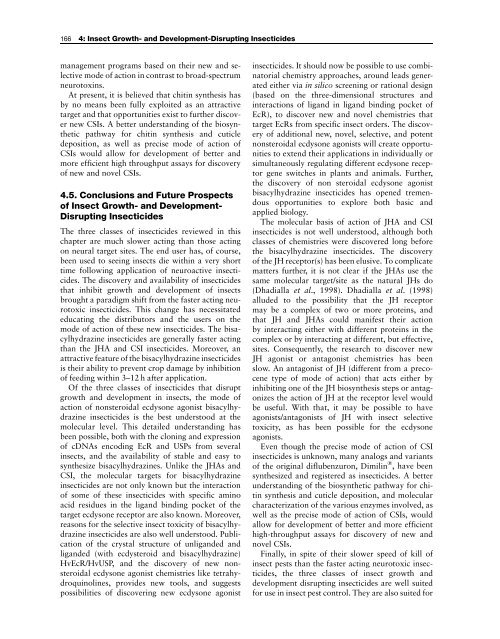Insect Control: Biological and Synthetic Agents - Index of
Insect Control: Biological and Synthetic Agents - Index of
Insect Control: Biological and Synthetic Agents - Index of
Create successful ePaper yourself
Turn your PDF publications into a flip-book with our unique Google optimized e-Paper software.
166 4: <strong>Insect</strong> Growth- <strong>and</strong> Development-Disrupting <strong>Insect</strong>icides<br />
management programs based on their new <strong>and</strong> selective<br />
mode <strong>of</strong> action in contrast to broad-spectrum<br />
neurotoxins.<br />
At present, it is believed that chitin synthesis has<br />
by no means been fully exploited as an attractive<br />
target <strong>and</strong> that opportunities exist to further discover<br />
new CSIs. A better underst<strong>and</strong>ing <strong>of</strong> the biosynthetic<br />
pathway for chitin synthesis <strong>and</strong> cuticle<br />
deposition, as well as precise mode <strong>of</strong> action <strong>of</strong><br />
CSIs would allow for development <strong>of</strong> better <strong>and</strong><br />
more efficient high throughput assays for discovery<br />
<strong>of</strong> new <strong>and</strong> novel CSIs.<br />
4.5. Conclusions <strong>and</strong> Future Prospects<br />
<strong>of</strong> <strong>Insect</strong> Growth- <strong>and</strong> Development-<br />
Disrupting <strong>Insect</strong>icides<br />
The three classes <strong>of</strong> insecticides reviewed in this<br />
chapter are much slower acting than those acting<br />
on neural target sites. The end user has, <strong>of</strong> course,<br />
been used to seeing insects die within a very short<br />
time following application <strong>of</strong> neuroactive insecticides.<br />
The discovery <strong>and</strong> availability <strong>of</strong> insecticides<br />
that inhibit growth <strong>and</strong> development <strong>of</strong> insects<br />
brought a paradigm shift from the faster acting neurotoxic<br />
insecticides. This change has necessitated<br />
educating the distributors <strong>and</strong> the users on the<br />
mode <strong>of</strong> action <strong>of</strong> these new insecticides. The bisacylhydrazine<br />
insecticides are generally faster acting<br />
than the JHA <strong>and</strong> CSI insecticides. Moreover, an<br />
attractive feature <strong>of</strong> the bisacylhydrazine insecticides<br />
is their ability to prevent crop damage by inhibition<br />
<strong>of</strong> feeding within 3–12 h after application.<br />
Of the three classes <strong>of</strong> insecticides that disrupt<br />
growth <strong>and</strong> development in insects, the mode <strong>of</strong><br />
action <strong>of</strong> nonsteroidal ecdysone agonist bisacylhydrazine<br />
insecticides is the best understood at the<br />
molecular level. This detailed underst<strong>and</strong>ing has<br />
been possible, both with the cloning <strong>and</strong> expression<br />
<strong>of</strong> cDNAs encoding EcR <strong>and</strong> USPs from several<br />
insects, <strong>and</strong> the availability <strong>of</strong> stable <strong>and</strong> easy to<br />
synthesize bisacylhydrazines. Unlike the JHAs <strong>and</strong><br />
CSI, the molecular targets for bisacylhydrazine<br />
insecticides are not only known but the interaction<br />
<strong>of</strong> some <strong>of</strong> these insecticides with specific amino<br />
acid residues in the lig<strong>and</strong> binding pocket <strong>of</strong> the<br />
target ecdysone receptor are also known. Moreover,<br />
reasons for the selective insect toxicity <strong>of</strong> bisacylhydrazine<br />
insecticides are also well understood. Publication<br />
<strong>of</strong> the crystal structure <strong>of</strong> unlig<strong>and</strong>ed <strong>and</strong><br />
lig<strong>and</strong>ed (with ecdysteroid <strong>and</strong> bisacylhydrazine)<br />
HvEcR/HvUSP, <strong>and</strong> the discovery <strong>of</strong> new nonsteroidal<br />
ecdysone agonist chemistries like tetrahydroquinolines,<br />
provides new tools, <strong>and</strong> suggests<br />
possibilities <strong>of</strong> discovering new ecdysone agonist<br />
insecticides. It should now be possible to use combinatorial<br />
chemistry approaches, around leads generated<br />
either via in silico screening or rational design<br />
(based on the three-dimensional structures <strong>and</strong><br />
interactions <strong>of</strong> lig<strong>and</strong> in lig<strong>and</strong> binding pocket <strong>of</strong><br />
EcR), to discover new <strong>and</strong> novel chemistries that<br />
target EcRs from specific insect orders. The discovery<br />
<strong>of</strong> additional new, novel, selective, <strong>and</strong> potent<br />
nonsteroidal ecdysone agonists will create opportunities<br />
to extend their applications in individually or<br />
simultaneously regulating different ecdysone receptor<br />
gene switches in plants <strong>and</strong> animals. Further,<br />
the discovery <strong>of</strong> non steroidal ecdysone agonist<br />
bisacylhydrazine insecticides has opened tremendous<br />
opportunities to explore both basic <strong>and</strong><br />
applied biology.<br />
The molecular basis <strong>of</strong> action <strong>of</strong> JHA <strong>and</strong> CSI<br />
insecticides is not well understood, although both<br />
classes <strong>of</strong> chemistries were discovered long before<br />
the bisacylhydrazine insecticides. The discovery<br />
<strong>of</strong> the JH receptor(s) has been elusive. To complicate<br />
matters further, it is not clear if the JHAs use the<br />
same molecular target/site as the natural JHs do<br />
(Dhadialla et al., 1998). Dhadialla et al. (1998)<br />
alluded to the possibility that the JH receptor<br />
may be a complex <strong>of</strong> two or more proteins, <strong>and</strong><br />
that JH <strong>and</strong> JHAs could manifest their action<br />
by interacting either with different proteins in the<br />
complex or by interacting at different, but effective,<br />
sites. Consequently, the research to discover new<br />
JH agonist or antagonist chemistries has been<br />
slow. An antagonist <strong>of</strong> JH (different from a precocene<br />
type <strong>of</strong> mode <strong>of</strong> action) that acts either by<br />
inhibiting one <strong>of</strong> the JH biosynthesis steps or antagonizes<br />
the action <strong>of</strong> JH at the receptor level would<br />
be useful. With that, it may be possible to have<br />
agonists/antagonists <strong>of</strong> JH with insect selective<br />
toxicity, as has been possible for the ecdysone<br />
agonists.<br />
Even though the precise mode <strong>of</strong> action <strong>of</strong> CSI<br />
insecticides is unknown, many analogs <strong>and</strong> variants<br />
<strong>of</strong> the original diflubenzuron, Dimilin Õ , have been<br />
synthesized <strong>and</strong> registered as insecticides. A better<br />
underst<strong>and</strong>ing <strong>of</strong> the biosynthetic pathway for chitin<br />
synthesis <strong>and</strong> cuticle deposition, <strong>and</strong> molecular<br />
characterization <strong>of</strong> the various enzymes involved, as<br />
well as the precise mode <strong>of</strong> action <strong>of</strong> CSIs, would<br />
allow for development <strong>of</strong> better <strong>and</strong> more efficient<br />
high-throughput assays for discovery <strong>of</strong> new <strong>and</strong><br />
novel CSIs.<br />
Finally, in spite <strong>of</strong> their slower speed <strong>of</strong> kill <strong>of</strong><br />
insect pests than the faster acting neurotoxic insecticides,<br />
the three classes <strong>of</strong> insect growth <strong>and</strong><br />
development disrupting insecticides are well suited<br />
for use in insect pest control. They are also suited for










